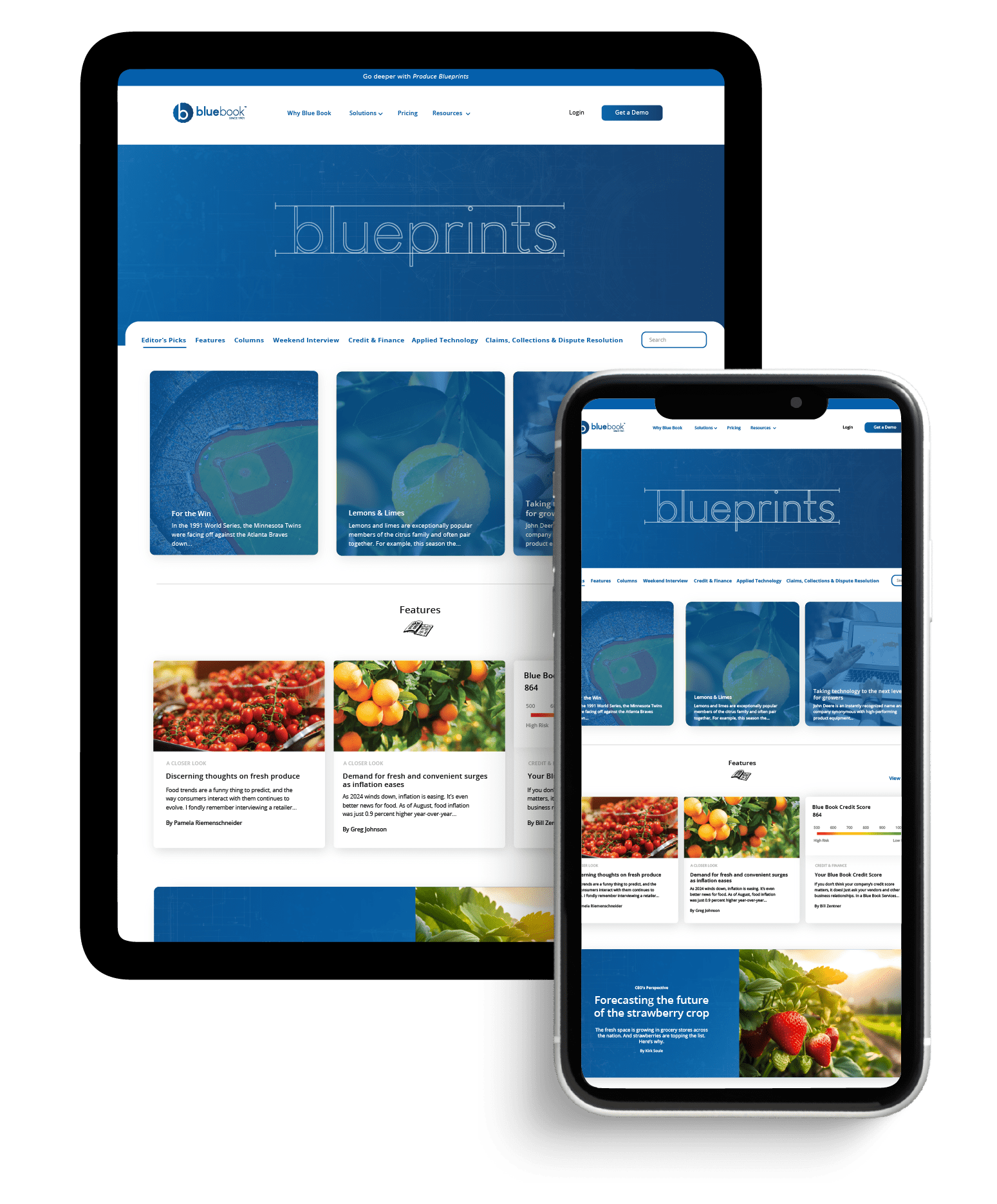Welcome to Blue Book!
Are you ready to join the thousands of companies who rely on Blue Book to drive smarter decisions? View our plans and get started today!
Still have questions? We’d love to show you what Blue Book can do for you. Drop us a line– we’ve been waiting for you.

If you don’t think your company’s credit score matters, it does! Just ask your vendors and other business relationships. In a Blue Book Services customer survey, we found Blue Book scores (and ratings) were the most favored feature by members.
And, based on daily interactions between Blue Book and the produce trade, nearly all say they pay close attention to Blue Book scores.
George Agorastos, sales and office manager for importer/exporter Arizona Sky Produce, Inc. BB #:269689 in Nogales, AZ, confirms the importance of customers having a good score. “It shows they have a good track record, are responsible, and handle their business well.”
John Hein, managing member of Fresno, CA-based grower and shipper Specialty Fresh, LLC BB #:300123, agrees. “It’s important for my customers and business partners to have a good Blue Book score so we can effectively evaluate their business performance prior to and/or while we decide on our level of financial exposure.”
The aforementioned is the foundation for why most companies monitor and manage their own credit profile, and ensure their Blue Book score is the best it can be.
What is a Blue Book Credit Score?
Scores have been here since 2006, so most industry veterans know how to interpret them. But for new entrants to the industry or those who aren’t as familiar, a Blue Book credit score is a three-digit output derived from reported trading experience data.
The score is used to suggest the financial stability and reliability of a company and if it will pay its obligations in a timely manner. In other words, Blue Book scores predict the likelihood of a company becoming delinquent and/or going into default.
Blue Book scores range from 500 to 999. The higher the value, the less risk of a negative event; the lower the value, the greater the risk. Our scoring “risk bands” are as follows: 500 to 599 = high risk, 600 to 699 = moderately high risk, 700 to 749 = moderate risk, 750 to 799 = moderately low risk, and 800 to 999 = low risk.
Scoring risk bands, also known as score ranges, categorize credit scores into different levels of risk based on historical credit events that have occurred within a particular band. This helps credit extenders assess the risk of lending to a buyer based on where its score falls within the outlined bands.
For example, a customer portfolio might have five companies scored at 900, five at 800, and two at 550. The overall risk portfolio would indicate there are 10 customers at a low risk of becoming delinquent or going into default, while two are high risk.
To further discuss risk, here’s a quick quiz.
What does a score of 600 mean to a credit extender? Answer: It would suggest the scored company pays obligations in a variable manner, often beyond terms. This would be considered a “moderately high risk” score.
What does a credit extender do with this insight? Answer: It depends, first and foremost, on risk tolerance. Credit extenders know they may receive payments more slowly than a higher-scored company, or in some cases not at all.
What does a score of 800 mean to a credit extender? Answer: Contrary to the company scored at 600, it would suggest this company would pay its obligations in a timely, consistent manner. This would be considered a “low risk” score.
This short Q&A might be obvious to most, but not everyone understands how scores are derived. In Blue Book’s recent survey, we found 58 percent knew where scores came from, while 35 percent somewhat understood, and the other 7 percent said they really didn’t know.
Where Scores Come From
Data fuels scores—inputs are analyzed within a scoring model through a proprietary algorithm. Trade experience surveys, which ask companies to rate experiences with their business partners, are a primary source of data.
Another key data input, and also used as a seller’s record of its trading experiences with customers, is accounts receivable (A/R) aging files. This data has been instrumental in our scores, improving their predictive abilities to quickly identify emerging trends.
The aggregate of this data results in a highly predictive score. Good, consistent trade experiences and solid A/R aging data = a good score.
Contributing data
Blue Book provides complimentary access to two risk management tools for sharing monthly A/R aging files: our online tool, appropriately named AR Reports, and 2) our Accounts Receivable Analysis Report, electronically delivered upon each file contributed.
It should be mentioned that all data contributions are submitted in the strictest confidence. Trade experience survey data is viewable via our Business Reports and online Trade Activity summary feature, but A/R aging data is only accessible by those who share it.
Sharing A/R aging files is an efficient and cost-effective way to report trade experiences. Submitting this information benefits you, your customers, and all other contributors. And, when companies share their A/R aging files, they can also receive deep discounts on Claims, Collections & Distrpute Resolution.
Better data equals better decisions—if you’d like to become an A/R contributor and gain access to this exclusive data, please contact a Blue Book representative to get started.
What’s the real benefit? That ‘simple three-digit value’ markets a company and provides quick insight into whether it will be a good business partner.
Are All Scores Created Equal?
Scores are an indication of risk at the present moment and based on data inputs. However, if data inputs are limited, scores are more susceptible to volatility, while scores based on deep data generally have greater stability.
For example, companies will ask Blue Book why or how their score is lower than another. It can be perplexing to an established, well-performing business to be scored lower than a less-tenured business with scarce data and experiences.
But it happens, and here’s one example of how: a newer business starts out paying its bills within 15 days and does so with great consistency for the better part of a year. This scenario will always generate a very strong, low-risk score output.
However, because its foundation and payment history is not deep, if there are changes—such as 30-day or 45-day pay—the score change could be more pronounced than for a company with a more extensive data set.
The more tenured company may have a lower but still low-risk score, however, its deep data set and length of tenure will likely show some historical data variability due to it having more real-world business experiences the younger company has not endured.
Here’s another way to look at it: if you compare a company with 20 years of industry tenure, ample data, and a score of 875 to a two-year-old company with a score of 925, though the scores have 50 points between them, the risk to sell is low for each based on the score. If the two-year-old company hits a “speed bump” for the first time, its score will no longer be 925.
Score direction is important to monitor. An ascending score, even if lower by standards, may have less risk because of its data path, while a descending score, though higher than the other, may still present greater risk due to its data path.
The word “may” is important here—trading risk is what a score says it is—but it’s important to note a company’s score path, along with other available or current data that might not be factored into the score yet.
Why Companies Monitor Their Own Score
Credit extenders must make difficult decisions every day, and these decisions often have an impact on their company’s bottom line. Selling to companies with predominantly lower scores may result in losses and cash flow constraints that put pressure on their own ability to pay obligations and foster growth.
There are a few reasons why a company might have a low score, and sometimes it’s as simple as keeping an updated credit profile.
With vendors and other credit extenders evaluating Blue Book scores, it’s important for companies to have as complete a credit profile as possible, and this includes a score representative of how they do business.
What’s the real benefit? That ‘simple three-digit value’ markets a company and provides quick insight into whether it will be a good business partner.
“We monitor our Blue Book score,” confirms Arizona Sky’s Agorastros. “It shows how responsible we are with our business—we want it as high as possible to make sure no doors are closed.”
Brooks Lisenbey of Pack Right, LLC BB #:206969, a distributor in Nogales, AZ, affirms, “When dealing with a new vendor, the Blue Book score is a tool suppliers can use to evaluate our ability. After a period of time, they know the truth about us.”
Yudi Persaud, president of S.K. Cornerstone Group Inc. BB #:209965, a trucking and transportation broker based in Kingsville, ON, says the company always strives for a good Blue Book score. “It helps attract carriers and customers,” he notes. “It provides confidence and they know they’ll get paid.”
So, a good score is good marketing!
Conclusion
Aside from survey results, Blue Book receives dozens of inquiries a month from customers asking about scores. Some want to know how to get one, others want to know why their company’s score changed, and if it went down, how they can improve it.
The answers are always closely tied to data and sharing information. Here are a few tips to build and maintain a good Blue Book score.
First, be sure to keep reference lists of vendors and other service providers current. This allows Blue Book to connect with the businesses a company deals with most frequently, since they’ll have the best insight on current pay performance.
Next, we suggest paying within terms and being as consistent as possible in payments to vendors and other service providers.
In some cases, a company might not be able to pay all trading partners due to a cash flow pinch or a dispute over a transaction. But in most cases, if these hiccups are limited, they shouldn’t have a significant impact if there’s a current list of references on file and data is abundant.
In paying close attention to their Blue Book score, most companies will avoid pitfalls—like being unable to secure the product they want, establish new customer relationships, or projecting a positive, stable image.
So, bottom line: keep Blue Book informed by submitting current reference lists, complete trade experience surveys when received, and confidentially share A/R aging files. Doing all three will benefit you, your trading partners, and the industry.
This article was originally published in the November/December 2024 edition.






